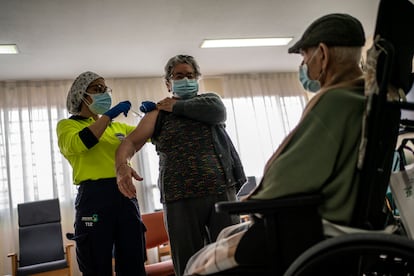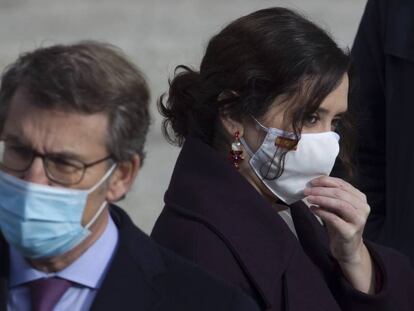January 2021 was the worst month for the pandemic in Spain since the summer
The central Health Ministry registered nearly 900,000 cases, a third of the total since the coronavirus crisis took hold

The figures from the first wave of the coronavirus in Spain will never be fully known. The system was so overwhelmed, and the capacity to carry out tests so limited, that only approximate statistics covering what happened between the end of the winter and the start of the spring in 2020 will ever be available. The situation was probably worse than the current one, but what has just been seen in January 2021 is reminiscent of the darkest months of the health crisis so far. By a long way, the first month of this year is the worst since the summer – since we have had reliable, homogeneous data – with practically double the number of cases diagnosed compared to October and November, and hospitalizations around 40% above the latter month, which was when the highest number of admissions was registered since there has been reliable data.
January saw 900,000 confirmed coronavirus cases, which is a third of the total recorded since the pandemic began. (It should be noted that the Health Ministry calculates that it is detecting nearly 80% of infections, while at the start of the pandemic it was only recording one in every 10.)
Simón warned that even with falling cases, it will still take weeks for the situation to normalize in the country’s hospitals
The positive news from the latest Health Ministry report, which was released on Monday night, is that the 14-day cumulative number of coronavirus cases per 100,000 inhabitants is now falling, coming in at 866 – down 25 compared to a week ago.
In the words of Fernando Simón, the director of the Health Ministry’s Coordination Center for Health Alerts (CCAES), this is still “incredibly high,” but, he explained, “it is starting to fall. And this is good, but we need for it to happen fast so that the activity in hospitals does not have to be reorganized.”
This disruption to normal hospital treatment, however, is already happening in many of Spain’s regions. Five territories – Castilla-La Mancha, Castilla y León, Catalonia and Madrid, and the North African city of Ceuta – have more than 50% of their intensive care unit (ICU) beds occupied by Covid patients, while Valencia, La Rioja and the North African city of Melilla are above 60%. “These figures are not compatible with normal functioning [of a hospital],” said Simón on Monday, warning that even with falling cases, it will still take weeks for the situation to normalize in the country’s hospitals. The average occupation of ICU beds by Covid patients (45.3%) as well as that of acute-care beds (24.6%) continues to rise across Spain.
What’s more, the Health Ministry yesterday added 762 new Covid victims to the overall death toll. This figure was down by five compared to last Monday. It should be noted that Monday’s figures account for Friday, Saturday and Sunday, and the victims added to the overall total did not necessarily pass away over the weekend. There are still considerable delays in the reporting process, which involves the regions collating their data before sending it to the central Health Ministry for inclusion on their official reports. The number of deaths will not start to fall significantly until hospital and ICU admissions are no longer rising.
Simón warned that the figures will not be considered acceptable until the 14-day cumulative number of coronavirus cases per 100,000 inhabitants falls below 200. Last night, journalists questioned the CCAES chief about a suggestion by the country’s tourism minister, Reyes Maroto, that trips in Spain could be permitted once more in time for the Easter holiday. Simón responded by saying that it would depend on the incidence. “This is not about going from 800 to 500, but rather much further,” he said. He described a level of 50 cases per 100,000 inhabitants as “utopian,” even though Spanish Prime Minister Pedro Sánchez had previously set a target of just 25.
Vaccines
With regard to Spain’s vaccination program, Simón stated that “with every week that passes there are fewer people at risk of infection thanks to the vaccines,” and he reiterated the objective of vaccinating 70% of the Spanish population by the “beginning of the summer,” between June and July. This is an earlier date than had been floated previously by current Health Minister Carolina Darias and her predecessor, Salvador Illa, who had spoken about reaching this target “during the summer,” which would mean as late as September.

Before then, the next target will be the vaccination of 80% of the over-80s in Spain, “between March and April.” To do this, it is likely that the Oxford-AstraZeneca vaccines will not be used. Although the European Commission has approved the inoculations, and clinical trials have shown that they are safe for this age group, the sample was not statistically significant to determine efficacy among the over-80s.
Countries such as Germany, Italy and Holland have already stated that they will use this vaccine for young people. Spain, however, is yet to take such a decision. Health officials will be meeting today to consider the issue and will make a recommendation to the Inter-Territorial Council of the National Health System (CISNS), which brings together the central Health Ministry and the regional health systems, who are in charge of their own vaccination programs as well as the local handling of the pandemic. “It’s possible that in the EU, we will follow the recommendation that Germany has made,” said Simón, in reference to the German authorities’ decision not to use the AstraZeneca vaccine among the elderly population. “This is prudent,” he continued, adding that to make the decision in Spain, health officials “will have to analyze the technical details of the vaccine.”
If such a decision is taken, changes will have to be made to the vaccination plan, including a different group in phase 2 along with the over-80s. One option could be younger people who have preexisting conditions that make them more vulnerable. In the Netherlands, for example, they are planning to vaccinate adults aged between 18 and 60 who have some kind of condition, such as diabetes, heart problems or lung conditions, Isabel Ferrer reports.
Another option could be to vaccinate essential workers, such as police officers and teachers. This would not necessarily mean a delay to the vaccination of seniors, provided that enough Pfizer-BioNTech and Moderna vaccines arrive, thus allowing for both groups to be inoculated.
English version by Simon Hunter.
Tu suscripción se está usando en otro dispositivo
¿Quieres añadir otro usuario a tu suscripción?
Si continúas leyendo en este dispositivo, no se podrá leer en el otro.
FlechaTu suscripción se está usando en otro dispositivo y solo puedes acceder a EL PAÍS desde un dispositivo a la vez.
Si quieres compartir tu cuenta, cambia tu suscripción a la modalidad Premium, así podrás añadir otro usuario. Cada uno accederá con su propia cuenta de email, lo que os permitirá personalizar vuestra experiencia en EL PAÍS.
¿Tienes una suscripción de empresa? Accede aquí para contratar más cuentas.
En el caso de no saber quién está usando tu cuenta, te recomendamos cambiar tu contraseña aquí.
Si decides continuar compartiendo tu cuenta, este mensaje se mostrará en tu dispositivo y en el de la otra persona que está usando tu cuenta de forma indefinida, afectando a tu experiencia de lectura. Puedes consultar aquí los términos y condiciones de la suscripción digital.
More information
Últimas noticias
Maduro pleads not guilty before the federal court in New York: ‘I am still the president of Venezuela’
A new test can detect Alzheimer’s from a finger prick
UN team enters Sudanese city of El Fasher after paramilitary massacre: ‘It’s like a ghost town’
A recipe for resistance: Indigenous peoples politicize their struggles from the kitchen
Most viewed
- Gilles Lipovetsky: ‘If you want to live better and fall in love, take Prozac, don’t look to philosophy’
- Alain Aspect, Nobel laureate in physics: ‘Einstein was so smart that he would have had to recognize quantum entanglement’
- Alvin Hellerstein, a 92-year-old judge appointed by Bill Clinton, to preside over Maduro’s trial in New York
- Why oil has been at the center of Venezuela-US conflicts for decades
- Maduro’s downfall puts China’s relationship with Venezuela to the test











































